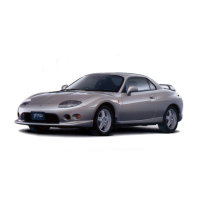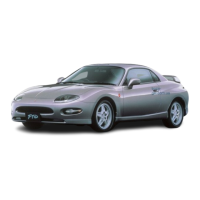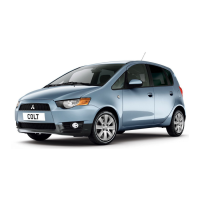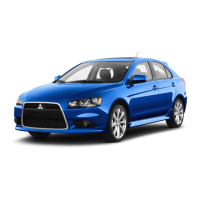12-31
CAUTION
When adding power steering fluid, be sure to
use fluid of the same brand as the existing fluid.
Mixing two or more different fluids will change
their properties and could cause a failure.
NOTE:
Inspect the power steering fluid level after stopping
the engine and allowing the power steering fluid to
cool. Increases in the fluid temperature cause
increases in the fluid level, so an accurate inspec-
tion of the level is not possible unless the fluid is
cold.
7.1 Inspecting and adding fluid
• Vehicles other than Crew-cab model
1. Make sure the parking brake is securely applied.
2. Manual transmission vehicles:
Place gearshift lever in the neutral position.
Automatic transmission vehicles:
Place the range selector lever in the “P” posi-
tion.
3. With the vehicle parked on level ground, place
the front wheels in the straight-ahead position
and stop the engine.
4. Apply chocks to the wheels and make sure the
vehicle does not move.
5. Tilt the cab. P. 12-5
6. Observe the power steering fluid level in the res-
ervoir tank .
7. If the fluid level is between the “MAX” and “MIN”
lines, it is acceptable.
8. If the fluid level is below the “MIN” line, clean the
reservoir tank’s cap and the surrounding area
then open the cap and add power steering fluid
until it reaches the “MAX” line.
9. Securely fit the cap.
• Crew-cab model
1. Make sure the parking brake is securely applied.
2. Manual transmission vehicles:
Place gearshift lever in the neutral position.
Automatic transmission vehicles:
Place the range selector lever in the “P” posi-
tion.
3. With the vehicle parked on level ground, place
the front wheels in the straight-ahead position
and stop the engine.
4. Apply chocks to the wheels and make sure the
vehicle does not move.
5. Open the inspection cover in the rear floor-
mat. Release the lock , then open the hatch
.
CAUTION
In certain cases, the inspection hatch may
remain at high temperatures for a certain period
of time after the engine has been stopped. In
order to prevent burns, avoid touching this
hatch or other parts of the engine until the tem-
perature has dropped sufficiently.
Z10729
Z12566
FEFG.book Page 31 Thursday, March 10, 2005 7:30 PM

